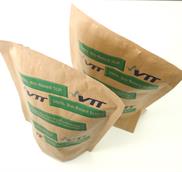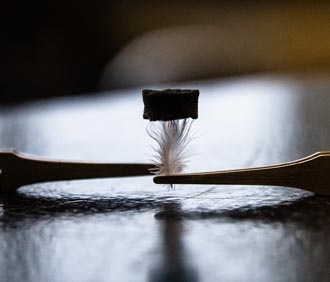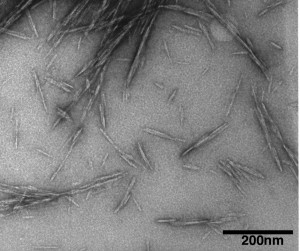Earlier this year in an April 10, 2014 post, I announced a then upcoming ‘nano commercialization’ workshop focused on cellulose nanomaterials in particular. While the report from the workshop, held in May, seems to have been published in August, news of its existence seems to have surfaced only now. From a Nov. 24, 2014 news item on Nanowerk (Note: A link has been removed),
The U.S. Forest Service has released a report that details the pathway to commercializing affordable, renewable, and biodegradable cellulose nanomaterials from trees. Cellulosic nanomaterials are tiny, naturally occurring structural building blocks and hold great promise for many new and improved commercial products. Commercializing these materials also has the potential to create hundreds of thousands of American jobs while helping to restore our nation’s forests.
“This report is yet another important step toward commercializing a material that can aid in restoring our nations’ forests, provide jobs, and improve products that make the lives of Americans better every day,” said U.S. Forest Service Chief Tom Tidwell. “The Forest Service plans to generate greater public and market awareness of the benefits and uses for these naturally-occurring nanomaterials.”
The report, titled “Cellulose Nanomaterials – A Path towards Commercialization” (pdf), is a result of a workshop held earlier this year that brought together a wide range of experts from industry, academia, and government to ensure that commercialization efforts are driven by market and user materials needs.
A Nov. 24, 2014 US Dept. of Agriculture news release (Note: The US Forest Service is a division of the US Dept. of Agriculture), which originated the news item, provides more detail about the reasons for holding the workshop (Note: A link has been removed),
Cellulose nanomaterials have the potential to add value to an array of new and improved products across a range of industries, including electronics, construction, food, energy, health care, automotive, aerospace, and defense, according to Ted Wegner, assistant director at the U.S. Forest Service Forest Products Laboratory in Madison, Wis.
“These environmentally friendly materials are extremely attractive because they have a unique combination of high strength, high stiffness, and light weight at what looks to be affordable prices,” Wegner explained. “Creating market pull for cellulose nanomaterials is critical to its commercialization.
The success of this commercialization effort is important to the U.S. Forest Service for another key reason: creating forests that are more resilient to disturbances through restorative actions. Removing excess biomass from overgrown forests and making it into higher value products like nanocellulose, is a win for the environment and for the economy.
“Finding high-value, high-volume uses for low-value materials is the key to successful forest restoration,” said Michael T. Rains, Director of the Northern Research Station and Forest Products Laboratory. “With about 400 million acres of America’s forests in need of some type of restorative action, finding markets for wood-based nanocellulose could have a huge impact on the economic viability of that work.”
The U.S. Forest Service, in collaboration with the U.S. National Nanotechnology Initiative, organized the workshop. Participants included over 130 stakeholders from large volume industrial users, specialty users, Federal Government agencies, academia, non-government organizations, cellulose nanomaterials manufactures and industry consultants. The workshop generated market-driven input in three areas: Opportunities for Commercialization, Barriers to Commercialization, and Research and Development Roles and Priorities. Issues identified by participants included the need for more data on materials properties, performance, and environmental, health, and safety implications and the need for a more aggressive U.S. response to opportunities for advancing and developing cellulose nanomaterial.
“The workshop was a great opportunity to get research ideas directly from the people who want to use the material,” says World Nieh, the U.S. Forest Service’s national program lead for forest products. “Getting the market perspective and finding out what barriers they have encountered is invaluable guidance for moving research in a direction that will bring cellulose nanomaterials into the marketplace for commercial use.”
The mission of the U.S. Forest Service, part U.S. Department of Agriculture, is to sustain the health, diversity and productivity of the nation’s forests and grasslands to meet the needs of present and future generations. The agency manages 193 million acres of public land, provides assistance to state and private landowners, and maintains the largest forestry research organization in the world. Public lands the Forest Service manages contribute more than $13 billion to the economy each year through visitor spending alone. Those same lands provide 20 percent of the nation’s clean water supply, a value estimated at $7.2 billion per year. The agency has either a direct or indirect role in stewardship of about 80 percent of the 850 million forested acres within the U.S., of which 100 million acres are urban forests where most Americans live.
The report titled, “Cellulose Nanomaterials – A Path towards Commercialization,” notes the situation from the US perspective (from p. 5 of the PDF report),
Despite great market potential, commercialization of cellulose nanomaterials in the United States is moving slowly. In contrast, foreign research, development, and deployment (RD&D) of cellulose nanomaterials has received significant governmental support through investments and coordination. [emphasis mine] U.S. RD&D activities have received much less government support and instead have relied on public-private partnerships and private sector investment. Without additional action to increase government investments and coordination, the United States could miss the window of opportunity for global leadership and end up being an “also ran” that has to import cellulose nanomaterials and products made by incorporating cellulose nanomaterials. If this happens, significant economic and social benefits would be lost. Accelerated commercialization for both the production and application of cellulose nanomaterials in a wide array of products is a critical national challenge.
I know the Canadian government has invested heavily in cellulose nanomaterials particularly in Québec (CelluForce, a DomTar and FPInnovations production facility for CNC [cellulose nanocrystals] also known as NCC [nanocrystalline cellulose]). There’s also some investment in Alberta (an unnamed CNC production facility) and Saskatchewan (Blue Goose Biorefineries). As for other countries and constituencies which come to mind and have reported on cellulose nanomaterial research, there’s Brazil, the European Union, Sweden, Finland, and Israel. I do not have details about government investments in those constituencies. I believe the report’s source supporting this contention is in Appendix E, (from p. 41 of the PDF report),
Moon, Robert, and Colleen Walker. 2012. “Research into Cellulose
Nanomaterials Spans the Globe.” Paper360 7(3): 32–34. EBSCOhost. Accessed June 17, 2014 [behind a paywall]
Here’s a description of the barriers to commercialization (from p. 6 of the PDF report),
Clarifying the problems to be solved is a precursor to identifying solutions. The workshop identified critical barriers that are slowing commercialization. These barriers included lack of collaboration among potential producers and users; coordination of efforts among government, industry, and academia; lack of characterization and standards for cellulose nanomaterials; the need for greater market pull; and the need to overcome processing technical challenges related to cellulose nanomaterials dewatering and dispersion. While significant, these barriers are not insurmountable as long as the underlying technical challenges are properly addressed. With the right focus and sufficient resources, R&D should be able to overcome these key identified barriers.
There’s a list of potential applications (p. 7 of the PDF report).
Cellulose nanomaterials have demonstrated potential applications in a wide array of industrial sectors, including electronics, construction, packaging, food, energy, health care, automotive, and defense. Cellulose nanomaterials are projected to be less expensive than many other nanomaterials and, among other characteristics, tout an impressive strength-to-weight ratio (Erickson 2012, 26). The theoretical strength-to-weight performance offered by cellulose nanomaterials are unmatched by current technology (NIST 2008,
17). Furthermore, cellulose nanomaterials have proven to have major environmental benefits because they are recyclable, biodegradable, and produced from renewable resources.
I wonder if that strength-to-weight ratio comment is an indirect reference to carbon nanotubes which are usually the ‘strength darlings’ of the nanotech community.
More detail about potential applications is given on p. 9 of the PDF report,
All forms of cellulose nanomaterials are lightweight, strong, and stiff. CNCs possess photonic and piezoelectric properties, while CNFs can provide very stable hydrogels and aerogels. In addition, cellulose nanomaterials have low materials cost potential compared to other competing materials and, in their unmodified state, have so far shown few environmental, health, and safety (EHS) concerns (Ireland, Jones, Moon, Wegner, and Nieh 2014, 6). Currently, cellulose nanomaterials have demonstrated great potential for use in many areas, including aerogels, oil drilling additives, paints, coatings, adhesives, cement, food additives, lightweight packaging materials, paper, health care products, tissue scaffolding, lightweight vehicle armor, space technology, and automotive parts. Hence, cellulose nanomaterials have the potential to positively impact numerous industries. An important attribute of cellulose nanomaterials is that they are derived from renewable and broadly available resources (i.e., plant, animal, bacterial, and algal biomass). They are biodegradable and bring recyclability to products that contain them.
This particular passage should sound a familiar note for Canadians, from p. 11 of the PDF report,
However, commercialization of cellulose nanomaterials in the United States has been moving slowly. Since 2009, the USDA Forest Service has invested around $20 million in cellulose nanomaterials R&D, a small fraction of the $680 million spent on cellulose nanomaterials R&D by governments worldwide (Erickson 2014, 26). In order to remain globally competitive, accelerated research, development, and commercialization
of cellulose nanomaterials in the United States is imperative. Otherwise, the manufacturing of cellulose nanomaterials and cellulose nanomaterial-enabled products will be established by foreign producers, and the United States will be purchasing these materials from other countries. [emphasis mine] Establishing a large-scale production of cellulose nanomaterials in the United States is critical for creating new uses from wood—which is, in turn, vital to the future of forest management and the livelihood of landowners.
Here are some of the challenges and barriers identified in the workshop (pp. 19 – 21 of the PDF report),
Need for Characterization and Standards:
In order for a new material to be adopted for use, it must be well understood and end users must have confidence that the material is the same from one batch to the next. There is a need to better characterize cellulose nanomaterials with respect to their structure, surface properties, and performance. …
Production and Processing Methods:
Commercialization is inhibited by the lack of processing and production methods and know-how for ensuring uniform, reliable, and cost-effective production of cellulose nanomaterials, especially at large volumes. This is both a scale-up and a process control issue. …
Need for More Complete EHS Information:
Limited EHS information creates a significant barrier to commercialization because any uncertainty regarding material safety and the pending regulatory environment presents risk for early movers across all industries. …
Need for Market Pull and Cost/Benefit Performance:
As noted earlier, cellulose nanomaterials have potential applications in a wide range of areas, but there is no single need that is driving their commercial development. Stakeholders suggested several reasons, including lack of awareness of the material and its properties and a need for better market understanding. Commercialization will require market pull in order to incentivize manufacturers, yet there is no perceptible demand for cellulose nanomaterials at the moment. …
Challenge of Dewatering/Drying:
One of the most significant technical challenges identified is the dewatering of cellulose nanomaterials into a dry and usable form for incorporation into other materials. The lack of an energy-efficient, cost-effective drying process inhibits commercialization of cellulose nanomaterials, particularly for non-aqueous applications. Cellulose nanomaterials in low-concentration aqueous suspensions raise resource and transportation costs, which make them less viable commercially.
Technology Readiness:
Technology readiness is a major challenge in the adoption of cellulose nanomaterials. One obstacle in developing a market for cellulose nanomaterials is the lack of information on the basic properties of different types of cellulose nanomaterials, as noted in the characterization and standards discussion. …
The rest of the report concerns Research & Development (R&D) Roles and Priorities and the Path Forward. In total, this document is 44 pp. long and includes a number of appendices. Here’s where you can read “Cellulose Nanomaterials – A Path towards Commercialization.”



![AGELESS BRILLIANCE: Although the pigment-derived leaf color of this decades-old specimen of the African perennial Pollia condensata has faded, the fruit still maintains its intense metallic-blue iridescence.COURTESY OF P.J. RUDALL [downloaded from http://www.the-scientist.com/?articles.view/articleNo/34200/title/Color-from-Structure/]](http://www.frogheart.ca/wp-content/uploads/2014/06/AgelessColour_-Pollia_condensata_Herbarium2.jpg)